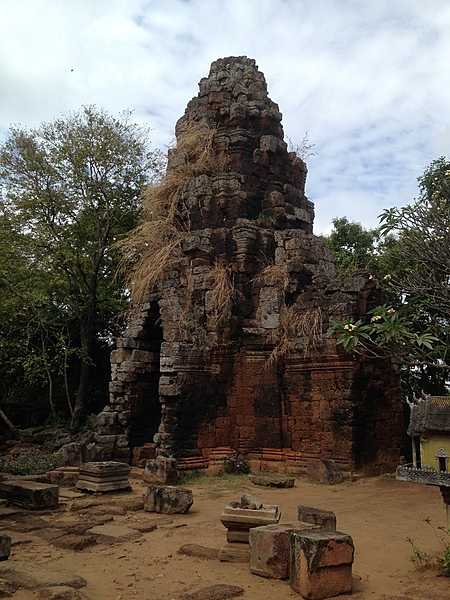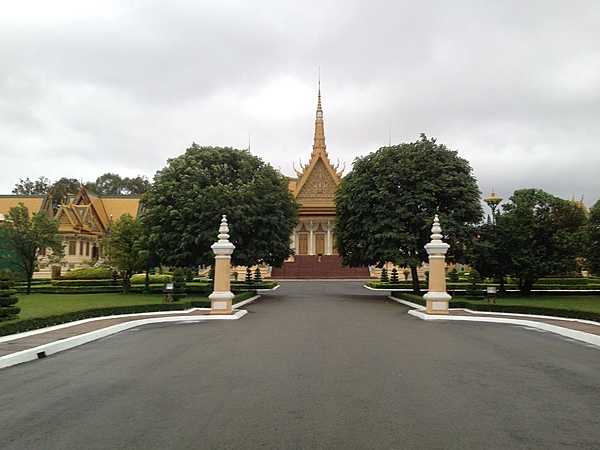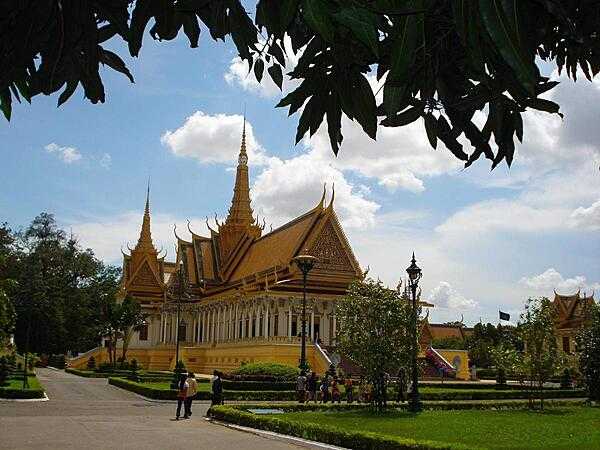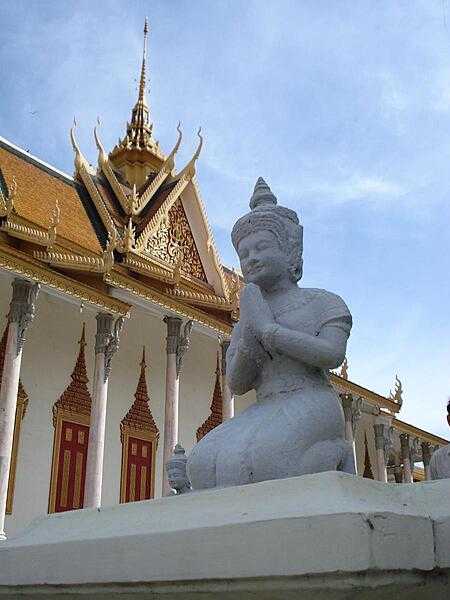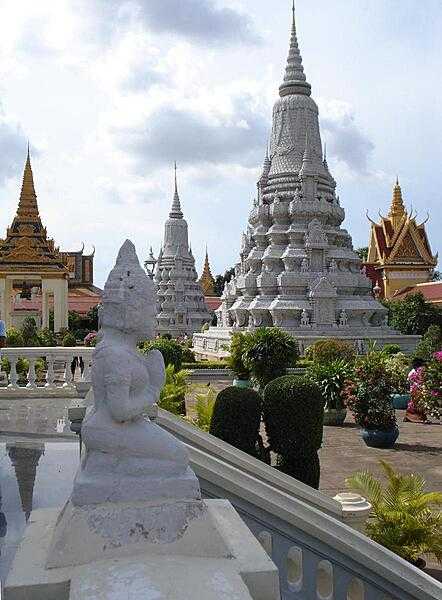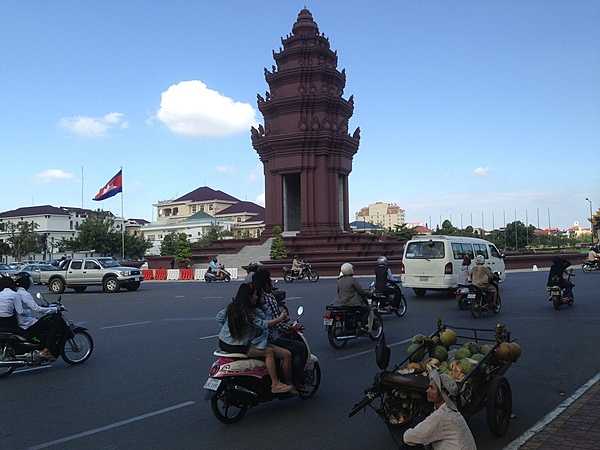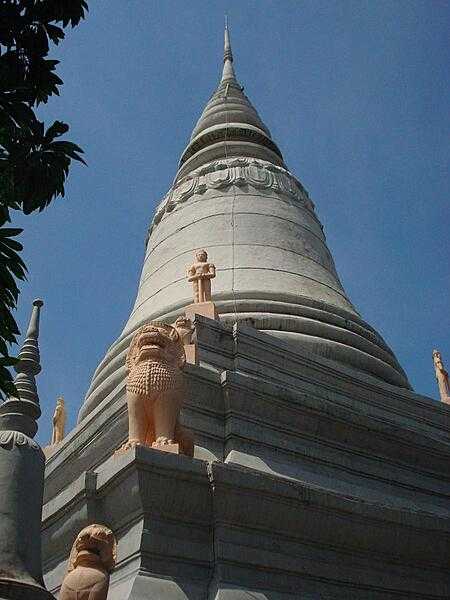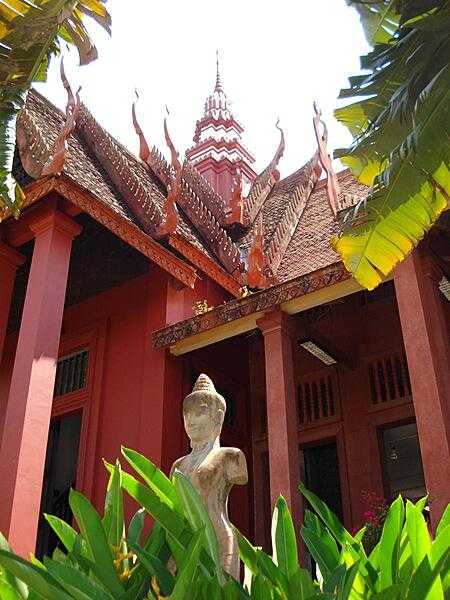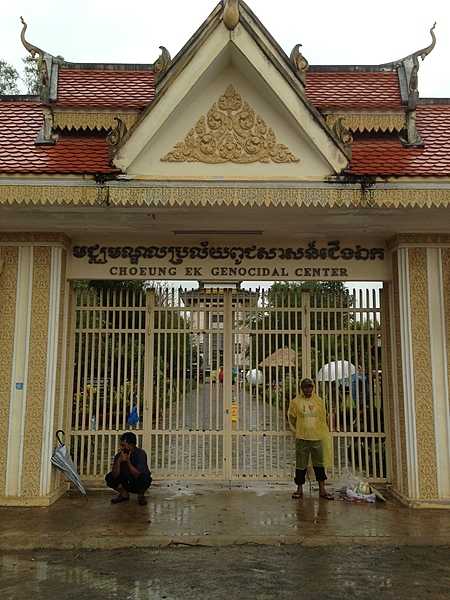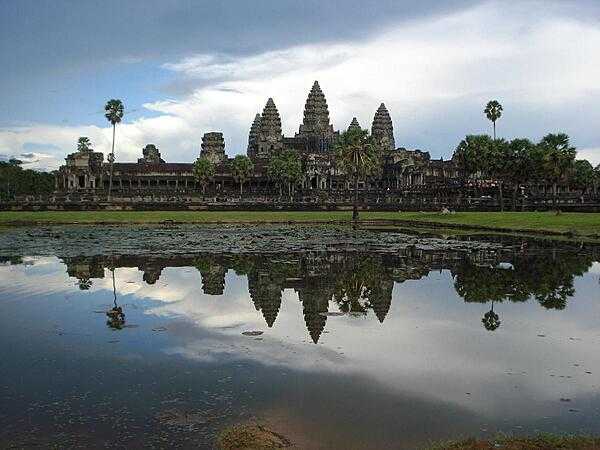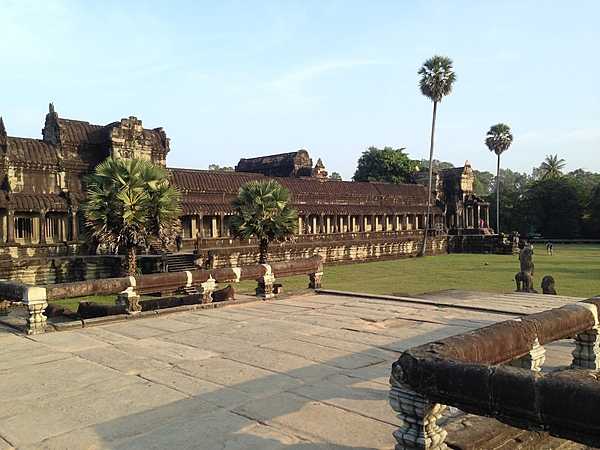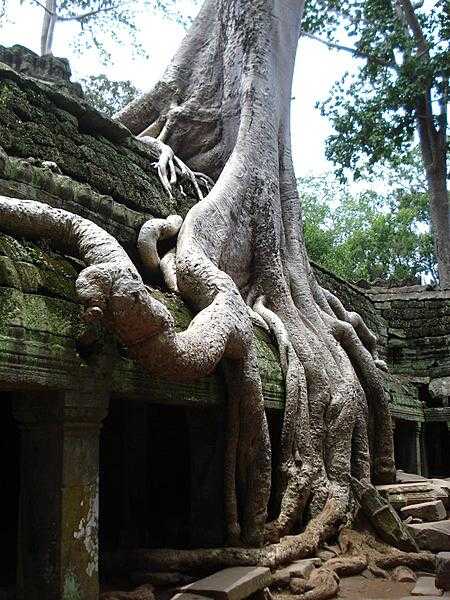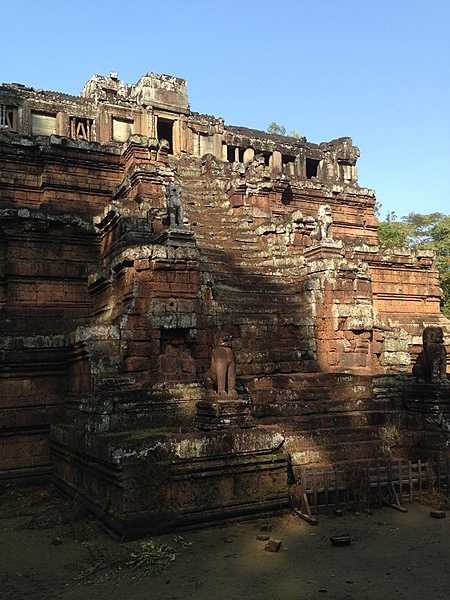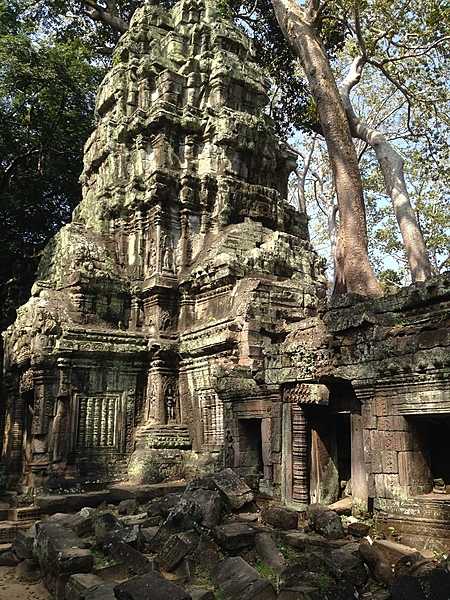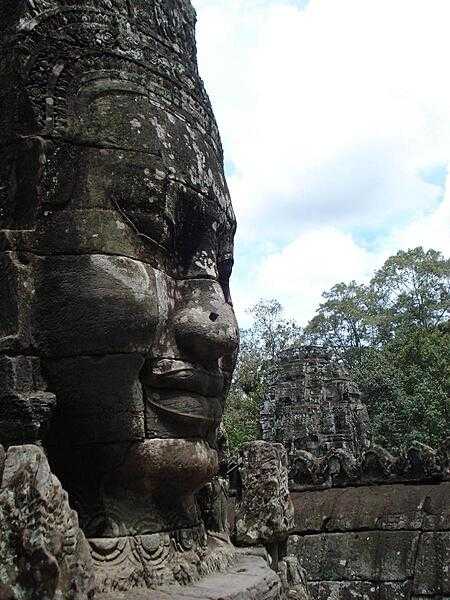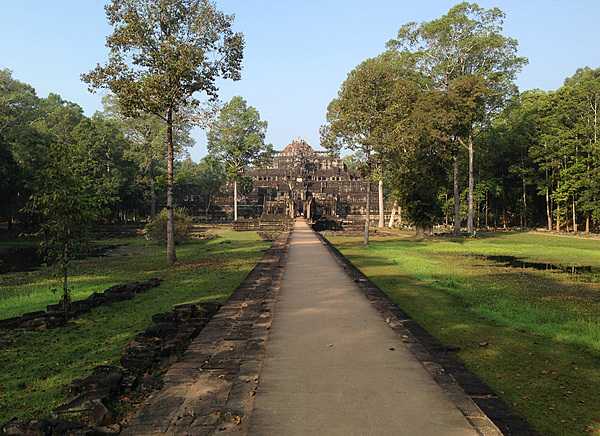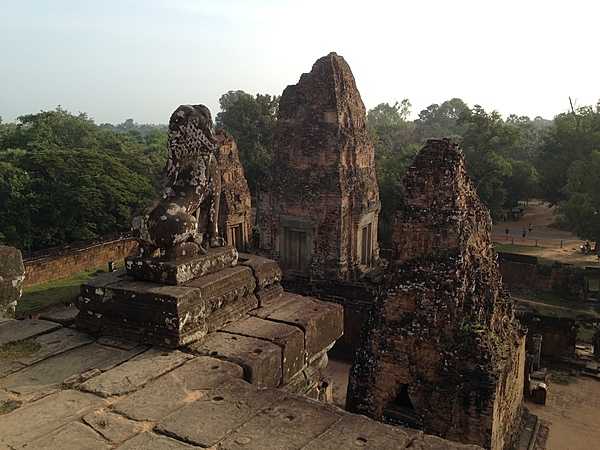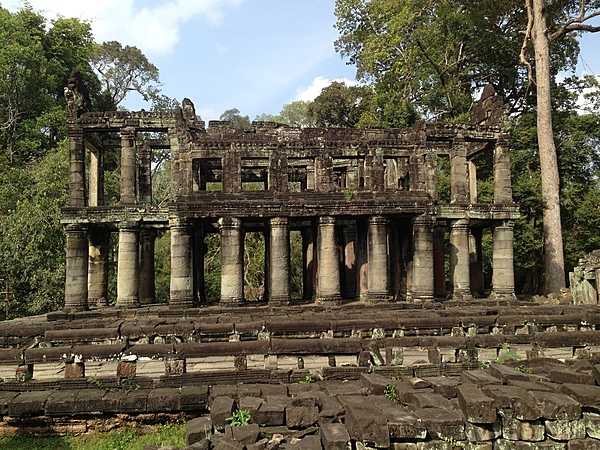Cambodia - KH - KHM - CAM - East and Southeast Asia
Last updated: December 10, 2025


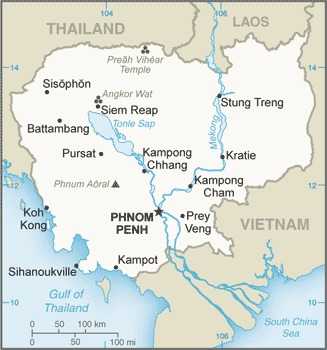
Cambodia Images
Cambodia Factbook Data
Diplomatic representation from the US
chief of mission: Ambassador (vacant); Chargé d’Affaires Bridgette L. WALKER (since August 2024)
embassy: #1, Street 96, Sangkat Wat Phnom, Khan Daun Penh, Phnom Penh
mailing address: 4540 Phnom Penh Place, Washington DC 20521-4540
telephone: [855] (23) 728-000
FAX: [855] (23) 728-700
email address and website:
ACSPhnomPenh@state.gov
https://kh.usembassy.gov/
embassy: #1, Street 96, Sangkat Wat Phnom, Khan Daun Penh, Phnom Penh
mailing address: 4540 Phnom Penh Place, Washington DC 20521-4540
telephone: [855] (23) 728-000
FAX: [855] (23) 728-700
email address and website:
ACSPhnomPenh@state.gov
https://kh.usembassy.gov/
Age structure
0-14 years: 28.9% (male 2,497,056/female 2,436,618)
15-64 years: 65.8% (male 5,456,941/female 5,765,206)
65 years and over: 5.3% (2024 est.) (male 323,591/female 584,257)
15-64 years: 65.8% (male 5,456,941/female 5,765,206)
65 years and over: 5.3% (2024 est.) (male 323,591/female 584,257)
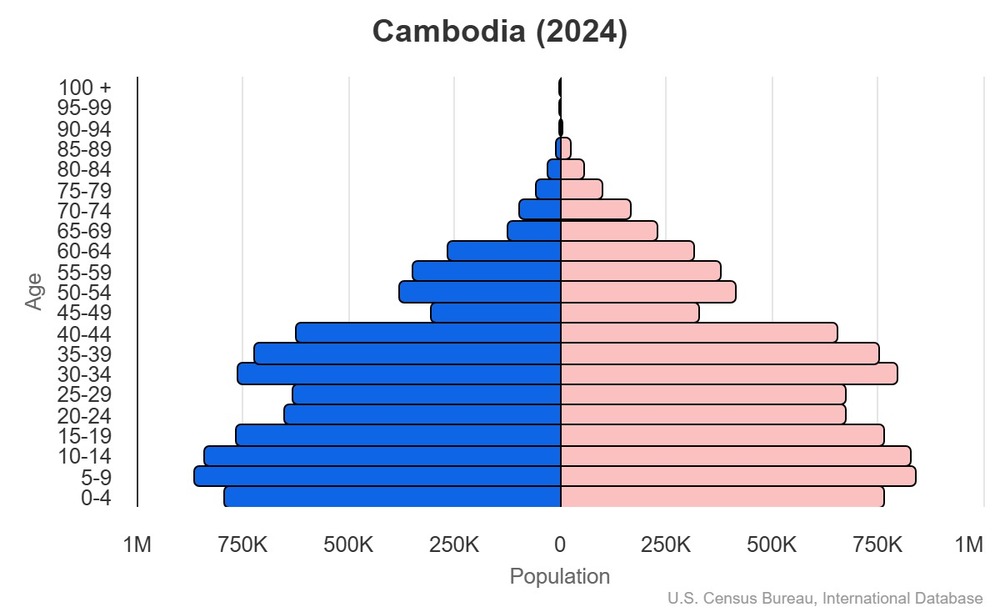
This is the population pyramid for Cambodia. A population pyramid illustrates the age and sex structure of a country's population and may provide insights about political and social stability, as well as economic development. The population is distributed along the horizontal axis, with males shown on the left and females on the right. The male and female populations are broken down into 5-year age groups represented as horizontal bars along the vertical axis, with the youngest age groups at the bottom and the oldest at the top. The shape of the population pyramid gradually evolves over time based on fertility, mortality, and international migration trends.
For additional information, please see the entry for Population pyramid on the Definitions and Notes page.
For additional information, please see the entry for Population pyramid on the Definitions and Notes page.
Geographic coordinates
13 00 N, 105 00 E
Sex ratio
at birth: 1.04 male(s)/female
0-14 years: 1.02 male(s)/female
15-64 years: 0.95 male(s)/female
65 years and over: 0.55 male(s)/female
total population: 0.94 male(s)/female (2024 est.)
0-14 years: 1.02 male(s)/female
15-64 years: 0.95 male(s)/female
65 years and over: 0.55 male(s)/female
total population: 0.94 male(s)/female (2024 est.)
Natural hazards
monsoonal rains (June to November); flooding; occasional droughts
Area - comparative
1.5 times the size of Pennsylvania; slightly smaller than Oklahoma
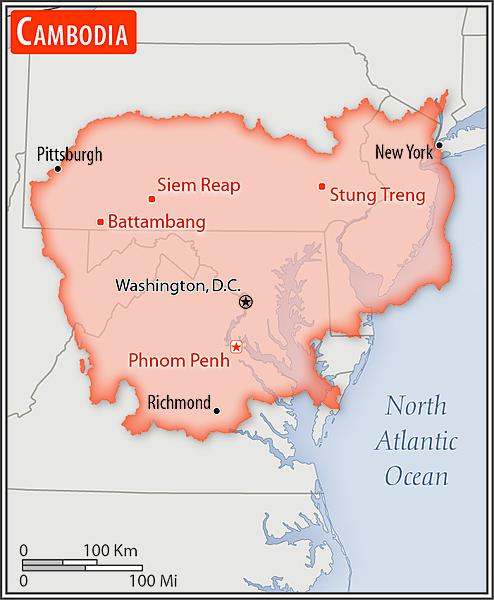
one and a half times the size of Pennsylvania; slightly smaller than Oklahoma
Military service age and obligation
18 is the legal minimum age for military service for men and women (2025)
note: in 2006, Cambodia's parliament approved a law requiring all Cambodians aged 18 to 30 to serve in the military for 18 months, although the law has never been enforced (service was to be voluntary for women); in 2025, the Cambodian Government announced that the 2006 conscription law would be enforced beginning in 2026 and have a 24-month service requirement
note: in 2006, Cambodia's parliament approved a law requiring all Cambodians aged 18 to 30 to serve in the military for 18 months, although the law has never been enforced (service was to be voluntary for women); in 2025, the Cambodian Government announced that the 2006 conscription law would be enforced beginning in 2026 and have a 24-month service requirement
Background
Most Cambodians consider themselves to be Khmers, descendants of the Angkor Empire that extended over much of Southeast Asia and reached its zenith between the 10th and 13th centuries. Attacks by the Thai and Cham (from present-day Vietnam) weakened the empire, ushering in a long period of decline. The king placed the country under French protection in 1863, and it became part of French Indochina in 1887. Following Japanese occupation in World War II, Cambodia gained full independence from France in 1953. In 1975, after a seven-year struggle, communist Khmer Rouge forces captured Phnom Penh and evacuated all cities and towns. At least 1.5 million Cambodians died from execution, forced hardships, or starvation during the Khmer Rouge regime under POL POT. A 1978 Vietnamese invasion drove the Khmer Rouge into the countryside, began a 10-year Vietnamese occupation, and touched off 13 years of internecine warfare in which a coalition of Khmer Rouge, Cambodian nationalists, and royalist insurgents, with assistance from China, fought the Vietnamese-backed People’s Republic of Kampuchea (PRK).
The 1991 Paris Agreements ended the country’s civil war and mandated democratic elections, which took place in 1993 and ushered in a period of multi-party democracy with a constitutional monarchy. King Norodom SIHANOUK was reinstated as head of state, and the Cambodian People's Party (CPP) and the royalist FUNCINPEC party formed a coalition government. Nevertheless, the power-sharing arrangement proved fractious and fragile, and in 1997, a coup led by CPP leader and former PRK prime minister HUN SEN dissolved the coalition and sidelined FUNCINPEC. Despite further attempts at coalition governance, the CPP has since remained in power through elections criticized for lacking fairness, political and judicial corruption, media control, and influence over labor unions, all of which have been enforced with violence and intimidation. HUN SEN remained as prime minister until 2023, when he transferred power to his son, HUN MANET. HUN SEN has subsequently maintained considerable influence as the leader of the CPP and the Senate. The CPP has also placed limits on civil society, press freedom, and freedom of expression. Despite some economic growth and considerable investment from China over the past decade, Cambodia remains one of East Asia's poorest countries.
The remaining elements of the Khmer Rouge surrendered in 1999. A UN-backed special tribunal established in Cambodia in 1997 tried some of the surviving Khmer Rouge leaders for crimes against humanity and genocide. The tribunal concluded in 2022 with three convictions.
The 1991 Paris Agreements ended the country’s civil war and mandated democratic elections, which took place in 1993 and ushered in a period of multi-party democracy with a constitutional monarchy. King Norodom SIHANOUK was reinstated as head of state, and the Cambodian People's Party (CPP) and the royalist FUNCINPEC party formed a coalition government. Nevertheless, the power-sharing arrangement proved fractious and fragile, and in 1997, a coup led by CPP leader and former PRK prime minister HUN SEN dissolved the coalition and sidelined FUNCINPEC. Despite further attempts at coalition governance, the CPP has since remained in power through elections criticized for lacking fairness, political and judicial corruption, media control, and influence over labor unions, all of which have been enforced with violence and intimidation. HUN SEN remained as prime minister until 2023, when he transferred power to his son, HUN MANET. HUN SEN has subsequently maintained considerable influence as the leader of the CPP and the Senate. The CPP has also placed limits on civil society, press freedom, and freedom of expression. Despite some economic growth and considerable investment from China over the past decade, Cambodia remains one of East Asia's poorest countries.
The remaining elements of the Khmer Rouge surrendered in 1999. A UN-backed special tribunal established in Cambodia in 1997 tried some of the surviving Khmer Rouge leaders for crimes against humanity and genocide. The tribunal concluded in 2022 with three convictions.
Environmental issues
habitat and biodiversity loss from illegal logging and strip mining; destruction of mangrove swamps; soil erosion; limited access to potable water in rural areas; illegal fishing and overfishing; deforestation leading to sediment build-up in coastal ecosystems
International environmental agreements
party to: Biodiversity, Climate Change, Climate Change-Kyoto Protocol, Climate Change-Paris Agreement, Comprehensive Nuclear Test Ban, Desertification, Endangered Species, Hazardous Wastes, Marine Life Conservation, Ozone Layer Protection, Ship Pollution, Tropical Timber 2006, Wetlands, Whaling
signed, but not ratified: Law of the Sea
signed, but not ratified: Law of the Sea
Military expenditures
1.5% of GDP (2024 est.)
1.5% of GDP (2023 est.)
2.1% of GDP (2022 est.)
2.3% of GDP (2021 est.)
2.3% of GDP (2020 est.)
1.5% of GDP (2023 est.)
2.1% of GDP (2022 est.)
2.3% of GDP (2021 est.)
2.3% of GDP (2020 est.)
Exports - commodities
garments, semiconductors, trunks and cases, footwear, gold (2023)
note: top five export commodities based on value in dollars
note: top five export commodities based on value in dollars
Exports - partners
USA 36%, Germany 6%, China 6%, Japan 6%, Thailand 5% (2023)
note: top five export partners based on percentage share of exports
note: top five export partners based on percentage share of exports
Administrative divisions
24 provinces (khett, singular and plural) and 1 municipality (krong, singular and plural)
provinces: Banteay Meanchey, Battambang, Kampong Cham, Kampong Chhnang, Kampong Speu, Kampong Thom, Kampot, Kandal, Kep, Koh Kong, Kratie, Mondolkiri, Oddar Meanchey, Pailin, Preah Sihanouk, Preah Vihear, Prey Veng, Pursat, Ratanakiri, Siem Reap, Stung Treng, Svay Rieng, Takeo, Tbong Khmum
municipalities: Phnom Penh (Phnum Penh)
provinces: Banteay Meanchey, Battambang, Kampong Cham, Kampong Chhnang, Kampong Speu, Kampong Thom, Kampot, Kandal, Kep, Koh Kong, Kratie, Mondolkiri, Oddar Meanchey, Pailin, Preah Sihanouk, Preah Vihear, Prey Veng, Pursat, Ratanakiri, Siem Reap, Stung Treng, Svay Rieng, Takeo, Tbong Khmum
municipalities: Phnom Penh (Phnum Penh)
Agricultural products
cassava, rice, maize, sugarcane, vegetables, oil palm fruit, rubber, bananas, jute, pork (2023)
note: top ten agricultural products based on tonnage
note: top ten agricultural products based on tonnage
Military and security forces
Royal Cambodian Armed Forces (RCAF): Royal Cambodian Army, Royal Khmer Navy, Royal Cambodian Air Force, Royal Gendarmerie (Military Police); National Committee for Maritime Security (2025)
note 1: the National Committee for Maritime Security performs coast guard functions and has representation from military and civilian agencies
note 2: the Cambodian National Police are under the Ministry of Interior
note 1: the National Committee for Maritime Security performs coast guard functions and has representation from military and civilian agencies
note 2: the Cambodian National Police are under the Ministry of Interior
Budget
revenues: $7.076 billion (2023 est.)
expenditures: $8.285 billion (2023 est.)
note: central government revenues (excluding grants) and expenditures converted to US dollars at average official exchange rate for year indicated
expenditures: $8.285 billion (2023 est.)
note: central government revenues (excluding grants) and expenditures converted to US dollars at average official exchange rate for year indicated
Capital
name: Phnom Penh
geographic coordinates: 11 33 N, 104 55 E
time difference: UTC+7 (12 hours ahead of Washington, DC, during Standard Time)
etymology: the name means "mountain of plenty," from the Cambodian words phnom (mountain or hill) and penh (full)
geographic coordinates: 11 33 N, 104 55 E
time difference: UTC+7 (12 hours ahead of Washington, DC, during Standard Time)
etymology: the name means "mountain of plenty," from the Cambodian words phnom (mountain or hill) and penh (full)
Imports - commodities
refined petroleum, fabric, gold, plastic products, synthetic fabric (2023)
note: top five import commodities based on value in dollars
note: top five import commodities based on value in dollars
Climate
tropical; rainy, monsoon season (May to November); dry season (December to April); little seasonal temperature variation
Coastline
443 km
Constitution
history: previous 1947; latest promulgated 21 September 1993
amendment process: proposed by the monarch, by the prime minister, or by the president of the National Assembly if supported by one fourth of the Assembly membership; passage requires two-thirds majority of the Assembly membership; constitutional articles on the multiparty democratic form of government and the monarchy cannot be amended
amendment process: proposed by the monarch, by the prime minister, or by the president of the National Assembly if supported by one fourth of the Assembly membership; passage requires two-thirds majority of the Assembly membership; constitutional articles on the multiparty democratic form of government and the monarchy cannot be amended
Exchange rates
riels (KHR) per US dollar -
Exchange rates:
4,072.397 (2024 est.)
4,110.653 (2023 est.)
4,102.038 (2022 est.)
4,098.723 (2021 est.)
4,092.783 (2020 est.)
Exchange rates:
4,072.397 (2024 est.)
4,110.653 (2023 est.)
4,102.038 (2022 est.)
4,098.723 (2021 est.)
4,092.783 (2020 est.)
Executive branch
chief of state: King Norodom SIHAMONI (since 29 October 2004)
head of government: Prime Minister HUN MANET (since 22 August 2023)
cabinet: Council of Ministers named by the prime minister and appointed by the monarch
election/appointment process: monarch chosen by the 9-member Royal Council of the Throne from among all eligible males of royal descent; after legislative elections, a member of the majority party or majority coalition is named prime minister by the Chairman of the National Assembly and appointed by the monarch
note: MANET succeeded his father, HUN SEN, who had been prime minister since 1985
head of government: Prime Minister HUN MANET (since 22 August 2023)
cabinet: Council of Ministers named by the prime minister and appointed by the monarch
election/appointment process: monarch chosen by the 9-member Royal Council of the Throne from among all eligible males of royal descent; after legislative elections, a member of the majority party or majority coalition is named prime minister by the Chairman of the National Assembly and appointed by the monarch
note: MANET succeeded his father, HUN SEN, who had been prime minister since 1985
Flag
description: three horizontal bands of blue (top), red (double-width), and blue; a three-towered, stylized white temple outlined in black is in the center of the red band, representing Angkor Wat
meaning: red and blue are traditional Cambodian colors
note: only national flag to prominently incorporate an identifiable building into its design; Afghanistan, San Marino, Portugal, and Spain show small generic buildings as part of their coats of arms on the flag
meaning: red and blue are traditional Cambodian colors
note: only national flag to prominently incorporate an identifiable building into its design; Afghanistan, San Marino, Portugal, and Spain show small generic buildings as part of their coats of arms on the flag
Independence
9 November 1953 (from France)
Industries
tourism, garments, construction, rice milling, fishing, wood and wood products, rubber, cement, gem mining, textiles
Judicial branch
highest court(s): Supreme Council (organized into 5- and 9-judge panels and includes a court chief and deputy chief); Constitutional Court (consists of 9 members)
judge selection and term of office: Supreme Court and Constitutional Council judge candidates recommended by the Supreme Council of Magistracy, a 17-member body chaired by the monarch and includes other high-level judicial officers; judges of both courts appointed by the monarch; Supreme Court judges appointed for life; Constitutional Council judges appointed for 9-year terms with one third of the court renewed every 3 years
subordinate courts: Appellate Court; provincial and municipal courts; Military Court
judge selection and term of office: Supreme Court and Constitutional Council judge candidates recommended by the Supreme Council of Magistracy, a 17-member body chaired by the monarch and includes other high-level judicial officers; judges of both courts appointed by the monarch; Supreme Court judges appointed for life; Constitutional Council judges appointed for 9-year terms with one third of the court renewed every 3 years
subordinate courts: Appellate Court; provincial and municipal courts; Military Court
Land boundaries
total: 2,530 km
border countries (3): Laos 555 km; Thailand 817 km; Vietnam 1158 km
border countries (3): Laos 555 km; Thailand 817 km; Vietnam 1158 km
Legal system
civil law system (influenced by the UN Transitional Authority in Cambodia), customary law, Communist legal theory, and common law
Legislative branch
legislature name: Parliament
legislative structure: bicameral
legislative structure: bicameral
Literacy
total population: 71.9% (2021 est.)
male: 81.5% (2021 est.)
female: 63.6% (2021 est.)
male: 81.5% (2021 est.)
female: 63.6% (2021 est.)
Maritime claims
territorial sea: 12 nm
contiguous zone: 24 nm
exclusive economic zone: 200 nm
continental shelf: 200 nm
contiguous zone: 24 nm
exclusive economic zone: 200 nm
continental shelf: 200 nm
International organization participation
ADB, ARF, ASEAN, CICA, EAS, FAO, G-77, IAEA, IBRD, ICAO, ICRM, IDA, IFAD, IFC, IFRCS, ILO, IMF, IMO, Interpol, IOC, IOM, IPU, ISO (correspondent), ITU, MIGA, NAM, OIF, OPCW, PCA, UN, UNAMID, UNCTAD, UNESCO, UNIDO, UNIFIL, UNISFA, UNMISS, UNWTO, UPU, WCO, WFTU (NGOs), WHO, WIPO, WMO, WTO
National holiday
Independence Day, 9 November (1953)
Nationality
noun: Cambodian(s)
adjective: Cambodian
adjective: Cambodian
Natural resources
oil and gas, timber, gemstones, iron ore, manganese, phosphates, hydropower potential, arable land
Geography - note
a land of paddies and forests dominated by the Mekong River and Tonle Sap (Southeast Asia's largest freshwater lake)
Economic overview
one of the fastest growing economies; tourism and clothing exports; substantial manufacturing and construction sectors; COVID-19 declines and the suspension of EU market preferential access; massive reductions in poverty, but rural areas remain disproportionately poor
Political parties
Candlelight Party or CP
Cambodian People's Party or CPP
Khmer Will Party or KWP
note 1: 18 parties registered to run in the 2023 parliamentary election
note 2: the Cambodian Government disqualified the Candlelight Party, the main opposition party, from the July 2023 election
Cambodian People's Party or CPP
Khmer Will Party or KWP
note 1: 18 parties registered to run in the 2023 parliamentary election
note 2: the Cambodian Government disqualified the Candlelight Party, the main opposition party, from the July 2023 election
Railways
total: 642 km (2014)
narrow gauge: 642 km (2014) 1.000-m gauge
note: under restoration
narrow gauge: 642 km (2014) 1.000-m gauge
note: under restoration
Suffrage
18 years of age; universal
Terrain
mostly low, flat plains; mountains in southwest and north
Government type
parliamentary constitutional monarchy
Country name
conventional long form: Kingdom of Cambodia
conventional short form: Cambodia
local long form: Preahreacheanachakr Kampuchea (phonetic transliteration)
local short form: Kampuchea
former: Khmer Republic, Democratic Kampuchea, People's Republic of Kampuchea, State of Cambodia
etymology: the name is derived from Kambu, a legendary ancestor of the Cambodian people
conventional short form: Cambodia
local long form: Preahreacheanachakr Kampuchea (phonetic transliteration)
local short form: Kampuchea
former: Khmer Republic, Democratic Kampuchea, People's Republic of Kampuchea, State of Cambodia
etymology: the name is derived from Kambu, a legendary ancestor of the Cambodian people
Location
Southeastern Asia, bordering the Gulf of Thailand, between Thailand, Vietnam, and Laos
Map references
Southeast Asia
Irrigated land
3,540 sq km (2012)
Diplomatic representation in the US
chief of mission: Ambassador Koy KUONG (since 11 June 2025)
chancery: 4530 16th Street NW, Washington, DC 20011
telephone: [1] (202) 726-7742
FAX: [1] (202) 726-8381
email address and website:
camemb.usa@mfaic.gov.kh
https://www.embassyofcambodiadc.org/
chancery: 4530 16th Street NW, Washington, DC 20011
telephone: [1] (202) 726-7742
FAX: [1] (202) 726-8381
email address and website:
camemb.usa@mfaic.gov.kh
https://www.embassyofcambodiadc.org/
Internet users
percent of population: 61% (2023 est.)
Internet country code
.kh
GDP (official exchange rate)
$46.353 billion (2024 est.)
note: data in current dollars at official exchange rate
note: data in current dollars at official exchange rate
Trafficking in persons
tier rating: Tier 3 — Cambodia does not fully meet the minimum standards for the elimination of trafficking and is not making significant efforts to do so, therefore, Cambodia remained on Tier 3; for more details, go to: https://www.state.gov/reports/2025-trafficking-in-persons-report/cambodia/
Total renewable water resources
476.1 billion cubic meters (2022 est.)
School life expectancy (primary to tertiary education)
total: 11 years (2023 est.)
male: 11 years (2023 est.)
female: 11 years (2023 est.)
male: 11 years (2023 est.)
female: 11 years (2023 est.)
Urbanization
urban population: 25.6% of total population (2023)
rate of urbanization: 3.06% annual rate of change (2020-25 est.)
rate of urbanization: 3.06% annual rate of change (2020-25 est.)
Broadcast media
mix of state-owned, joint public-private, and privately owned broadcast media; 27 TV stations, with most operating on multiple channels, including 1 state-operated station with multiple locations and 11 stations either jointly operated or privately owned, some with several locations; multi-channel cable and satellite systems; 84 radio stations, including 1 state-owned broadcaster with multiple stations and a mix of public and private broadcasters; one international broadcaster is available, as well as one TV station that is jointly run by China and the Ministry of Interior; several TV and radio operators broadcast online only (often via Facebook) (2019)
Drinking water source
improved:
urban: 93.6% of population (2022 est.)
rural: 72.8% of population (2022 est.)
total: 78% of population (2022 est.)
unimproved:
urban: 6.4% of population (2022 est.)
rural: 27.2% of population (2022 est.)
total: 22% of population (2022 est.)
urban: 93.6% of population (2022 est.)
rural: 72.8% of population (2022 est.)
total: 78% of population (2022 est.)
unimproved:
urban: 6.4% of population (2022 est.)
rural: 27.2% of population (2022 est.)
total: 22% of population (2022 est.)
National anthem(s)
title: "Nokoreach" (Royal Kingdom)
lyrics/music: CHUON NAT/F. PERRUCHOT and J. JEKYLL
history: adopted 1941, restored 1993; the anthem, based on a Cambodian folk tune, was restored after the defeat of the Communist regime
lyrics/music: CHUON NAT/F. PERRUCHOT and J. JEKYLL
history: adopted 1941, restored 1993; the anthem, based on a Cambodian folk tune, was restored after the defeat of the Communist regime
This is an audio of the National Anthem for Cambodia. The national anthem is generally a patriotic musical composition - usually in the form of a song or hymn of praise - that evokes and eulogizes the history, traditions, or struggles of a nation or its people. National anthems can be officially recognized as a national song by a country's constitution or by an enacted law, or simply by tradition. Although most anthems contain lyrics, some do not.
Major urban areas - population
2.281 million PHNOM PENH (capital) (2023)
International law organization participation
accepts compulsory ICJ jurisdiction with reservations; accepts ICCt jurisdiction
Physician density
0.21 physicians/1,000 population (2019)
Hospital bed density
0.7 beds/1,000 population (2018 est.)
National symbol(s)
Angkor Wat temple, kouprey (wild ox)
Mother's mean age at first birth
23.3 years (2021-22 est.)
note: data represents median age at first birth among women 25-49
note: data represents median age at first birth among women 25-49
GDP - composition, by end use
household consumption: 59.8% (2024 est.)
government consumption: 5.8% (2024 est.)
investment in fixed capital: 31.6% (2024 est.)
investment in inventories: 0.6% (2024 est.)
exports of goods and services: 71.4% (2024 est.)
imports of goods and services: -72.1% (2024 est.)
note: figures may not total 100% due to rounding or gaps in data collection
government consumption: 5.8% (2024 est.)
investment in fixed capital: 31.6% (2024 est.)
investment in inventories: 0.6% (2024 est.)
exports of goods and services: 71.4% (2024 est.)
imports of goods and services: -72.1% (2024 est.)
note: figures may not total 100% due to rounding or gaps in data collection
Dependency ratios
total dependency ratio: 52.1 (2024 est.)
youth dependency ratio: 44 (2024 est.)
elderly dependency ratio: 8.1 (2024 est.)
potential support ratio: 12.4 (2024 est.)
youth dependency ratio: 44 (2024 est.)
elderly dependency ratio: 8.1 (2024 est.)
potential support ratio: 12.4 (2024 est.)
Citizenship
citizenship by birth: no
citizenship by descent only: at least one parent must be a citizen of Cambodia
dual citizenship recognized: yes
residency requirement for naturalization: 7 years
citizenship by descent only: at least one parent must be a citizen of Cambodia
dual citizenship recognized: yes
residency requirement for naturalization: 7 years
Population distribution
population concentrated in the southeast, particularly in and around the capital of Phnom Penh; further distribution is linked closely to the Tonle Sap and Mekong Rivers
Electricity access
electrification - total population: 92.3% (2022 est.)
electrification - urban areas: 99%
electrification - rural areas: 88%
electrification - urban areas: 99%
electrification - rural areas: 88%
Civil aircraft registration country code prefix
XU
Sanitation facility access
improved:
urban: 100% of population (2022 est.)
rural: 79.6% of population (2022 est.)
total: 84.7% of population (2022 est.)
unimproved:
urban: 0% of population (2022 est.)
rural: 20.4% of population (2022 est.)
total: 15.3% of population (2022 est.)
urban: 100% of population (2022 est.)
rural: 79.6% of population (2022 est.)
total: 84.7% of population (2022 est.)
unimproved:
urban: 0% of population (2022 est.)
rural: 20.4% of population (2022 est.)
total: 15.3% of population (2022 est.)
Ethnic groups
Khmer 95.4%, Cham 2.4%, Chinese 1.5%, other 0.7% (2019-20 est.)
Religions
Buddhist (official) 97.1%, Muslim 2%, Christian 0.3%, other 0.5% (2019 est.)
Languages
Khmer (official) 95.8%, minority languages 2.9%, Chinese 0.6%, Vietnamese 0.5%, other 0.2% (2019 est.)
major-language sample(s):
សៀវភៅហេតុការណនៅលើពិភពលោក។ ទីតាំងពត៏មានមូលដានគ្រឹះយាងសំខាន់។. (Khmer)
The World Factbook, the indispensable source for basic information.
major-language sample(s):
សៀវភៅហេតុការណនៅលើពិភពលោក។ ទីតាំងពត៏មានមូលដានគ្រឹះយាងសំខាន់។. (Khmer)
The World Factbook, the indispensable source for basic information.
Khmer audio sample
Imports - partners
China 39%, Thailand 20%, Vietnam 12%, Singapore 6%, Indonesia 3% (2023)
note: top five import partners based on percentage share of imports
note: top five import partners based on percentage share of imports
Refugees and internally displaced persons
refugees: 28 (2024 est.)
IDPs: 2,526 (2024 est.)
stateless persons: 75,000 (2024 est.)
IDPs: 2,526 (2024 est.)
stateless persons: 75,000 (2024 est.)
Elevation
highest point: Phnum Aoral 1,810 m
lowest point: Gulf of Thailand 0 m
mean elevation: 126 m
lowest point: Gulf of Thailand 0 m
mean elevation: 126 m
Health expenditure
7.5% of GDP (2021)
7% of national budget (2022 est.)
7% of national budget (2022 est.)
Military - note
the primary responsibilities of the Royal Cambodian Armed Forces (RCAF) are border, coastal, and internal security; key security partners include China and Vietnam; in July 2025, following months of rising tensions, the RCAF and the military forces of Thailand clashed in multiple locations along their disputed border; both sides blamed the other for provoking the five-day conflict, which included cross-border artillery shelling by both sides and air attacks by RTARF fighter aircraft and drones
the RCAF was re-established in 1993 under the first coalition government from the merger of the Cambodian Government’s military forces (Cambodian People’s Armed Forces) and the two non-communist resistance forces (Sihanoukist National Army, aka National Army for Khmer Independence, and the Khmer People's National Liberation Armed Forces); thousands of communist Khmer Rouge fighters began surrendering by 1994 under a government amnesty program and the last of the Khmer Rouge forces (National Army of Democratic Kampuchea) were demobilized or absorbed into the RCAF in 1999 (2025)
the RCAF was re-established in 1993 under the first coalition government from the merger of the Cambodian Government’s military forces (Cambodian People’s Armed Forces) and the two non-communist resistance forces (Sihanoukist National Army, aka National Army for Khmer Independence, and the Khmer People's National Liberation Armed Forces); thousands of communist Khmer Rouge fighters began surrendering by 1994 under a government amnesty program and the last of the Khmer Rouge forces (National Army of Democratic Kampuchea) were demobilized or absorbed into the RCAF in 1999 (2025)
Military and security service personnel strengths
information varies; estimated 200,000 Armed Forces, including Gendarmerie (2025)
Military equipment inventories and acquisitions
the RCAF is armed largely with older Chinese and Russian-origin equipment; in recent years it has received limited amounts of more modern equipment from several suppliers, particularly China (2024)
note: in December 2021, the US Government halted arms-related trade with Cambodia, citing deepening Chinese military influence, corruption, and human rights abuses by the government and armed forces; the policy of denial applied to licenses or other approvals for exports and imports of defense articles and defense services destined for or originating in Cambodia, with exceptions (on a case-by-case basis) related to conventional weapons destruction and humanitarian demining activities
note: in December 2021, the US Government halted arms-related trade with Cambodia, citing deepening Chinese military influence, corruption, and human rights abuses by the government and armed forces; the policy of denial applied to licenses or other approvals for exports and imports of defense articles and defense services destined for or originating in Cambodia, with exceptions (on a case-by-case basis) related to conventional weapons destruction and humanitarian demining activities
Total water withdrawal
municipal: 98 million cubic meters (2022 est.)
industrial: 33 million cubic meters (2022 est.)
agricultural: 2.053 billion cubic meters (2022 est.)
industrial: 33 million cubic meters (2022 est.)
agricultural: 2.053 billion cubic meters (2022 est.)
Waste and recycling
municipal solid waste generated annually: 1.089 million tons (2024 est.)
percent of municipal solid waste recycled: 12.4% (2022 est.)
percent of municipal solid waste recycled: 12.4% (2022 est.)
Average household expenditures
on food: 40.7% of household expenditures (2023 est.)
on alcohol and tobacco: 1.9% of household expenditures (2023 est.)
on alcohol and tobacco: 1.9% of household expenditures (2023 est.)
National heritage
total World Heritage Sites: 5 (all cultural)
selected World Heritage Site locales: Angkor; Temple of Preah Vihear; Sambor Prei Kuk; Koh Ker: Archaeological Site of Ancient Lingapora or Chok Gargyar; Cambodian Memorial Sites: From centres of repression to places of peace and reflection (c)
selected World Heritage Site locales: Angkor; Temple of Preah Vihear; Sambor Prei Kuk; Koh Ker: Archaeological Site of Ancient Lingapora or Chok Gargyar; Cambodian Memorial Sites: From centres of repression to places of peace and reflection (c)
Major watersheds (area sq km)
Pacific Ocean drainage: Mekong (805,604 sq km)
Major lakes (area sq km)
fresh water lake(s): Tonle Sap - 2,700-16,000 sq km
Major rivers (by length in km)
Mekong (shared with China [s], Burma, Thailand, Laos, and Vietnam [m]) - 4,350 km
note: [s] after country name indicates river source; [m] after country name indicates river mouth
note: [s] after country name indicates river source; [m] after country name indicates river mouth
Coal
production: 27,000 metric tons (2023 est.)
consumption: 4.39 million metric tons (2023 est.)
imports: 4.36 million metric tons (2023 est.)
consumption: 4.39 million metric tons (2023 est.)
imports: 4.36 million metric tons (2023 est.)
Electricity generation sources
fossil fuels: 55.5% of total installed capacity (2023 est.)
solar: 5.8% of total installed capacity (2023 est.)
hydroelectricity: 38.6% of total installed capacity (2023 est.)
biomass and waste: 0.1% of total installed capacity (2023 est.)
solar: 5.8% of total installed capacity (2023 est.)
hydroelectricity: 38.6% of total installed capacity (2023 est.)
biomass and waste: 0.1% of total installed capacity (2023 est.)
Petroleum
refined petroleum consumption: 77,000 bbl/day (2023 est.)
Gross reproduction rate
1.06 (2024 est.)
Remittances
6.1% of GDP (2024 est.)
6.6% of GDP (2023 est.)
6.5% of GDP (2022 est.)
note: personal transfers and compensation between resident and non-resident individuals/households/entities
6.6% of GDP (2023 est.)
6.5% of GDP (2022 est.)
note: personal transfers and compensation between resident and non-resident individuals/households/entities
Child marriage
women married by age 15: 1.9% (2022)
women married by age 18: 17.9% (2022)
men married by age 18: 3.3% (2022)
women married by age 18: 17.9% (2022)
men married by age 18: 3.3% (2022)
Ports
total ports: 2 (2024)
large: 0
medium: 1
small: 0
very small: 1
ports with oil terminals: 1
key ports: Kampong Saom, Phsar Ream
large: 0
medium: 1
small: 0
very small: 1
ports with oil terminals: 1
key ports: Kampong Saom, Phsar Ream
Legislative branch - lower chamber
chamber name: National Assembly (Radhsphea Ney Preah Recheanachakr Kampuchea)
number of seats: 125 (all directly elected)
electoral system: proportional representation
scope of elections: full renewal
term in office: 5 years
most recent election date: 7/23/2023
parties elected and seats per party: Cambodian People's Party (CPP) (120); Other (5)
percentage of women in chamber: 13.6%
expected date of next election: July 2028
number of seats: 125 (all directly elected)
electoral system: proportional representation
scope of elections: full renewal
term in office: 5 years
most recent election date: 7/23/2023
parties elected and seats per party: Cambodian People's Party (CPP) (120); Other (5)
percentage of women in chamber: 13.6%
expected date of next election: July 2028
Legislative branch - upper chamber
chamber name: Senate
number of seats: 62 (60 indirectly elected; 2 appointed)
scope of elections: full renewal
term in office: 6 years
most recent election date: 2/25/2024
percentage of women in chamber: 19.4%
expected date of next election: February 2030
number of seats: 62 (60 indirectly elected; 2 appointed)
scope of elections: full renewal
term in office: 6 years
most recent election date: 2/25/2024
percentage of women in chamber: 19.4%
expected date of next election: February 2030
National color(s)
red, blue
National coat of arms
Cambodia’s coat of arms is also the Royal Arms of Cambodia; the lions symbolize strength, courage, and the divine protection of the monarchs; the lion on the left is a gajasingha (a lion with an elephant’s trunk), and the lion on the right is a rajasingha (royal lion); both hold five-tiered umbrellas representing the king and queen, and they stand on a blue ribbon that says “Preah Chao Krung Kampuche”' (King of the Kingdom of Cambodia); between the lions is a crown with the Unalome, the Buddhist and Hindu symbol for the spiritual path to enlightenment, under it and a ray of light on top

Cambodia’s coat of arms -- which is also the Royal Arms of Cambodia – has many references to the country’s monarchy. The left lion, a gajasingha (a composite of a lion with an elephant’s trunk), and the right lion, a rajasingha (royal lion), symbolize strength, courage, and the divine protection of the monarchs. Both lions hold five-tiered umbrellas representing the king and queen, and they stand on a blue ribbon that says “Preah Chao Krung Kampuche”' (King of the Kingdom of Cambodia). Between the lions is a crown with the Unalome, the Buddhist and Hindu symbol for the spiritual path to enlightenment, under it and a ray of light on top.
Particulate matter emissions
18.4 micrograms per cubic meter (2019 est.)
Labor force
9.904 million (2024 est.)
note: number of people ages 15 or older who are employed or seeking work
note: number of people ages 15 or older who are employed or seeking work
Youth unemployment rate (ages 15-24)
total: 0.8% (2024 est.)
male: 0.7% (2024 est.)
female: 0.9% (2024 est.)
note: % of labor force ages 15-24 seeking employment
male: 0.7% (2024 est.)
female: 0.9% (2024 est.)
note: % of labor force ages 15-24 seeking employment
Net migration rate
-2.6 migrant(s)/1,000 population (2024 est.)
Median age
total: 27.9 years (2024 est.)
male: 26.9 years
female: 28.9 years
male: 26.9 years
female: 28.9 years
Debt - external
$8.019 billion (2023 est.)
note: present value of external debt in current US dollars
note: present value of external debt in current US dollars
Maternal mortality ratio
137 deaths/100,000 live births (2023 est.)
Reserves of foreign exchange and gold
$22.506 billion (2024 est.)
$19.984 billion (2023 est.)
$17.801 billion (2022 est.)
note: holdings of gold (year-end prices)/foreign exchange/special drawing rights in current dollars
$19.984 billion (2023 est.)
$17.801 billion (2022 est.)
note: holdings of gold (year-end prices)/foreign exchange/special drawing rights in current dollars
Public debt
50.3% of GDP (2023 est.)
note: central government debt as a % of GDP
note: central government debt as a % of GDP
Total fertility rate
2.17 children born/woman (2024 est.)
Unemployment rate
0.3% (2024 est.)
0.3% (2023 est.)
0.3% (2022 est.)
note: % of labor force seeking employment
0.3% (2023 est.)
0.3% (2022 est.)
note: % of labor force seeking employment
Population
total: 17,063,669 (2024 est.)
male: 8,277,588
female: 8,786,081
male: 8,277,588
female: 8,786,081
Carbon dioxide emissions
18.779 million metric tonnes of CO2 (2023 est.)
from coal and metallurgical coke: 8.026 million metric tonnes of CO2 (2023 est.)
from petroleum and other liquids: 10.753 million metric tonnes of CO2 (2023 est.)
from coal and metallurgical coke: 8.026 million metric tonnes of CO2 (2023 est.)
from petroleum and other liquids: 10.753 million metric tonnes of CO2 (2023 est.)
Area
total : 181,035 sq km
land: 176,515 sq km
water: 4,520 sq km
land: 176,515 sq km
water: 4,520 sq km
Taxes and other revenues
12.2% (of GDP) (2023 est.)
note: central government tax revenue as a % of GDP
note: central government tax revenue as a % of GDP
Real GDP (purchasing power parity)
$123.676 billion (2024 est.)
$116.658 billion (2023 est.)
$111.095 billion (2022 est.)
note: data in 2021 dollars
$116.658 billion (2023 est.)
$111.095 billion (2022 est.)
note: data in 2021 dollars
Airports
12 (2025)
Infant mortality rate
total: 27.9 deaths/1,000 live births (2024 est.)
male: 31.3 deaths/1,000 live births
female: 24.4 deaths/1,000 live births
male: 31.3 deaths/1,000 live births
female: 24.4 deaths/1,000 live births
Telephones - mobile cellular
total subscriptions: 19.5 million (2022 est.)
subscriptions per 100 inhabitants: 116 (2022 est.)
subscriptions per 100 inhabitants: 116 (2022 est.)
Inflation rate (consumer prices)
2.1% (2023 est.)
5.3% (2022 est.)
2.9% (2021 est.)
note: annual % change based on consumer prices
5.3% (2022 est.)
2.9% (2021 est.)
note: annual % change based on consumer prices
Current account balance
$222.108 million (2024 est.)
$552.346 million (2023 est.)
-$7.582 billion (2022 est.)
note: balance of payments - net trade and primary/secondary income in current dollars
$552.346 million (2023 est.)
-$7.582 billion (2022 est.)
note: balance of payments - net trade and primary/secondary income in current dollars
Real GDP per capita
$7,000 (2024 est.)
$6,700 (2023 est.)
$6,500 (2022 est.)
note: data in 2021 dollars
$6,700 (2023 est.)
$6,500 (2022 est.)
note: data in 2021 dollars
Broadband - fixed subscriptions
total: 510,000 (2022 est.) Slowly increase as focus is on mobile internet
subscriptions per 100 inhabitants: 3 (2022 est.)
subscriptions per 100 inhabitants: 3 (2022 est.)
Tobacco use
total: 14.5% (2025 est.)
male: 24.9% (2025 est.)
female: 4.7% (2025 est.)
male: 24.9% (2025 est.)
female: 4.7% (2025 est.)
Obesity - adult prevalence rate
3.9% (2016)
Energy consumption per capita
15.664 million Btu/person (2023 est.)
Death rate
5.7 deaths/1,000 population (2024 est.)
Birth rate
18.2 births/1,000 population (2024 est.)
Electricity
installed generating capacity: 3.673 million kW (2023 est.)
consumption: 16.998 billion kWh (2023 est.)
imports: 5.096 billion kWh (2023 est.)
transmission/distribution losses: 1.882 billion kWh (2023 est.)
consumption: 16.998 billion kWh (2023 est.)
imports: 5.096 billion kWh (2023 est.)
transmission/distribution losses: 1.882 billion kWh (2023 est.)
Merchant marine
total: 195 (2023)
by type: container ship 2, general cargo 123, oil tanker 18, other 52
by type: container ship 2, general cargo 123, oil tanker 18, other 52
Imports
$34.329 billion (2024 est.)
$29.421 billion (2023 est.)
$34.759 billion (2022 est.)
note: balance of payments - imports of goods and services in current dollars
$29.421 billion (2023 est.)
$34.759 billion (2022 est.)
note: balance of payments - imports of goods and services in current dollars
Exports
$31.712 billion (2024 est.)
$27.753 billion (2023 est.)
$25.497 billion (2022 est.)
note: balance of payments - exports of goods and services in current dollars
$27.753 billion (2023 est.)
$25.497 billion (2022 est.)
note: balance of payments - exports of goods and services in current dollars
Heliports
1 (2025)
Telephones - fixed lines
total subscriptions: 38,000 (2022 est.)
subscriptions per 100 inhabitants: (2022 est.) less than 1
subscriptions per 100 inhabitants: (2022 est.) less than 1
Alcohol consumption per capita
total: 4.56 liters of pure alcohol (2019 est.)
beer: 4.12 liters of pure alcohol (2019 est.)
wine: 0.03 liters of pure alcohol (2019 est.)
spirits: 0.41 liters of pure alcohol (2019 est.)
other alcohols: 0 liters of pure alcohol (2019 est.)
beer: 4.12 liters of pure alcohol (2019 est.)
wine: 0.03 liters of pure alcohol (2019 est.)
spirits: 0.41 liters of pure alcohol (2019 est.)
other alcohols: 0 liters of pure alcohol (2019 est.)
Life expectancy at birth
total population: 71.4 years (2024 est.)
male: 69.6 years
female: 73.3 years
male: 69.6 years
female: 73.3 years
Real GDP growth rate
6% (2024 est.)
5% (2023 est.)
5.1% (2022 est.)
note: annual GDP % growth based on constant local currency
5% (2023 est.)
5.1% (2022 est.)
note: annual GDP % growth based on constant local currency
Industrial production growth rate
9.5% (2024 est.)
note: annual % change in industrial value added based on constant local currency
note: annual % change in industrial value added based on constant local currency
GDP - composition, by sector of origin
agriculture: 16.6% (2024 est.)
industry: 41.8% (2024 est.)
services: 35.6% (2024 est.)
note: figures may not total 100% due to non-allocated consumption not captured in sector-reported data
industry: 41.8% (2024 est.)
services: 35.6% (2024 est.)
note: figures may not total 100% due to non-allocated consumption not captured in sector-reported data
Population growth rate
0.99% (2024 est.)
Land use
agricultural land: 34.9% (2023 est.)
arable land: 23.3% (2023 est.)
permanent crops: 3% (2023 est.)
permanent pasture: 8.5% (2023 est.)
forest: 39.4% (2023 est.)
other: 25.8% (2023 est.)
arable land: 23.3% (2023 est.)
permanent crops: 3% (2023 est.)
permanent pasture: 8.5% (2023 est.)
forest: 39.4% (2023 est.)
other: 25.8% (2023 est.)
Military deployments
340 Central African Republic (MINUSCA); 180 Lebanon (UNIFIL) (2025)
Currently married women (ages 15-49)
67.2% (2022 est.)
Children under the age of 5 years underweight
16.3% (2021 est.)
Education expenditure
2.2% of GDP (2023 est.)
11.6% national budget (2025 est.)
11.6% national budget (2025 est.)
